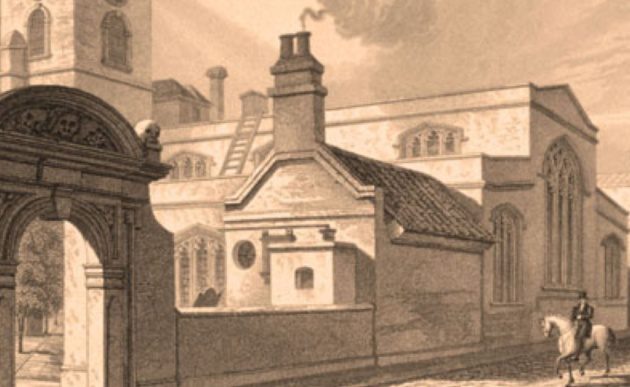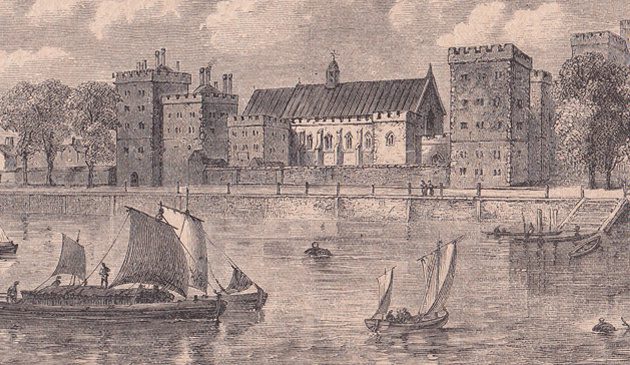The Fifty New Churches Act

St. George’s, Bloomsbury was one of several of the ‘Fifty Churches’ designed by Nicholas Hawksmoor and was completed in 1731. Unusually, it features a statue of King George I atop the steeple. The church is probably best known for its depiction in William Hogarth’s engraving ‘Gin Lane’.
Non-conformist chapels around London were overflowing with worshipers. In 1710 the Anglican-supporting Tories returned to power after more than two decades in opposition. They resolved to strengthen the Church of England by building magnificent new churches. It resulted in some of the finest London churches since those of Sir Christopher Wren a generation earlier.
Throughout the 17th century Protestant worship in England divided into those who stayed faithful to the Anglican Church of England and others who followed one of the various non-conformist doctrines, such as Presbyterians, Quakers, Congregationalists and Baptists, generally known as Dissenters. During the Commonwealth and Protectorate periods after the Civil War it was the latter groups who held political power.
Following the Restoration of the Monarchy in 1660 the Church of England resumed as the official Church and regulations were passed that discriminated against Dissenters in London, forcing them to move out to surrounding villages. The pendulum began to swing the other way again when William III, a member of the Dutch Reformed Church, became King.
It was noted by contemporaries that Anglican churches – most probably in the old City of London – were often less than full while services at Dissenter chapels – most probably in the surrounding villages – were so oversubscribed there was not enough room to accommodate the congregation. Indeed, thousands of immigrants from the Continent had arrived in London during the latter 17th century (such as Huguenots fleeing persecution in France), settling in the new suburbs outside of the City: at Spitalfields, Soho and Mile End. They were unburdened by laws and able to setup new chapels in their communities. On the other hand, large numbers of Anglicans had migrated out from the old City to surrounding suburbs and villages after their homes and businesses were destroyed in the Great Fire of 1666. Yet, unlike Dissenter chapels, the creation of new Church of England establishments was legally restricted by laws regarding parish boundaries, making it difficult to build official new churches where they were required. Church Commissioners calculated there was a theoretical need for 50 new churches to satisfy the spiritual needs of the Anglican population around the London. That did not take into account the willingness of parishioners to fund them, however, which they would be required to do by law through payment of rates.
During the late 17th and early 18th centuries English politics was dividing into opposing sides that would evolve into what we now call party-politics. At one extreme were Whigs who generally tolerated Dissenters and were therefore supported by them. On the opposite side were Tories, many of whom were extreme in their support of the Anglican Church and intolerant of Dissenters. Whigs held political power for much of the reign of William and Mary while their opponents remained largely in Opposition. The Tories finally swept to power in the general election of 1710 after 22 years. Frustrated by watching the rise of non-conformist Protestantism for so long, and powerless to act, it was finally time for them to redress the balance in places of worship and to strengthen the Church of England.
Following the Great Fire in 1666 Parliament instigated a tax on coal arriving in London, using the funds to pay for reconstruction of churches and public buildings. In November 1711 the roof of the old medieval St. Alfege, parish church of Greenwich, collapsed. Lacking the funds to repair the ancient building the parishioners petitioned Parliament. They argued that for years they had paid the coal tax and contributed to the rebuilding of the distant City and now the continuing income should be used in their time of need.
The petition of the parishioners was timely and their arguments fell on the receptive ears of the new Tory government of the Anglican Queen Anne. An Act of Parliament was passed into law with the aim of building 50 new churches using the continuing income from the coal tax, of which St. Alfege, Greenwich would be the first. (The Greenwich parishioners were extremely lucky. In the same year the Anglicans of Rotherhithe were refused money for the rebuilding of their parish church of St. Mary from the Fifty Churches funds and had to raise finance elsewhere).
According to the Act, a Commission was established to oversee the building programme. Its original members were the architects Sir Christopher Wren, Sir John Vanbrugh and Thomas Archer. Vanbrugh wrote at the time of the need for grandeur and magnificence in the new churches and he and Wren recommended towers with spires and porticoes, reflected in a resolution of the Committee in July 1712. In October 1711 they appointed the Surveyors Nicholas Hawksmoor and William Dickinson from the Queen’s Office of Works to organise the designs, obtain estimates and appoint workmen. Two years later Dickinson left the Office and was replaced by James Gibbs. Although not the original intention, Hawksmoor and Gibbs began proposing their own grand designs for the new buildings.
Nicholas Hawksmoor was perhaps the finest architect of his generation. He had worked as deputy to Wren since he arrived in London at the age of 18 and assisted in work at the Chelsea Military Hospital, Greenwich Naval Hospital, Kensington Palace and the rebuilding of numerous City churches after the Great Fire. He had a close working relationship with not only Wren but also another of the Commissioners, John Vanbrugh, with whom he had helped build the great country houses of Castle Howard and Blenheim Palace.
Hawksmoor began with St. Alfege in 1712 but instead of merely proposing a repair he submitted an entire remodelling of the building. It included a plan to replace the medieval tower with an octagonal lantern, which the commissioners refused to fund. The design for pilasters was added by Thomas Archer. The main work was completed in 1714. The tower was eventually replaced by John James in 1730.
Hawksmoor was also responsible for the three grandest of those churches completed, all in east London. St. George-in-the-East and St. Anne, Limehouse were built concurrently and have similarities, giving the impression they were designed at the same time in around 1712. St. Anne’s was built on open fields but St. George’s had to be set back and hidden from the main street because the plot acquired was behind a row of houses. For the latter he re-used his idea for the octagonal lantern that had been rejected for St. Alfege. Christ Church, Spitalfields (from 1714) was built to make a strong statement to the non-conformist Huguenot residents of the area and eventually cost over four times its early budget. Hawksmoor’s original plan was for a flat front and box-tower but after the main body of the building was completed in 1723 he added a grand portico and tower, completed in 1729. The original steeple was replaced in the 19th century.
St. Mary Woolnoth, close to the Royal Exchange in the City, was begun in 1716. It had survived the Great Fire and only needed patching up by Christopher Wren in the latter 17th century. However, by 1712 it was in a poor state and, like St. Alfege, it was agreed that it would be rebuilt from coal tax funds by Hawksmoor. It is the smallest of all the ‘Fifty’ churches and the simplest inside.
Hawksmoor’s biggest challenge was St. George’s, Bloomsbury because the site, purchased from the widow of Lord John Russell, was very narrow on its east-west axis but wide on its north-south due to houses that existed at the time but were subsequently demolished. It went through many changes from its initial design in 1711, including one by Vanbrugh in 1715, but Hawksmoor produced two more plans after that and was eventually given the commission. The distinctive tower was unusually topped by a statue of George I in Roman toga, the only statue of the King that exists in England.


